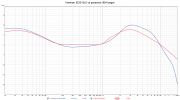That is a
really bad idea if you want to be certain that what you'll experience is the Harman target. That design is far too sensitive to coupling issues, and it isn't just a question of leakage.
An illustration of the issue of knowing what the Harman target is supposed to sound like :
https://audiosciencereview.com/foru...-noise-cancelling-headphone.25609/post-995729
It's fairly easy to know with headphones like the AirPods Max how the Harman target is supposed to sound like (and how it's supposed measure like with various in-ear mics, on my own head) below 800Hz. It's a lot harder past that frequency.
If I average several headphones, either after EQing them to the Harman target according to third party presets, or by using Harman's own headphones, how should I go exactly ? Because, at least with the rather small sample size that I can muster up, there isn't a superb agreement past 1kHz or so (and at lower frequencies, but that's just because Harman's passive headphones behave poorly in terms of leakage).
Using blocked ear canal entrance microphones (which may introduce inaccuracies above 1.5kHz or so, but less so when dealing with averages of several headphones), here's what happens when I average the following headphones, after averaging their R and L channels, with the number of samples used :
A) EQed to Harman target according to Oratory's presets : HD560S x1 + HD58X x1 + HD650 x1 + HE400SE x1 + K371 x1 + Hi-X65 x2 + AirPods Max x1
B) EQed to Harman target according to Oratory's presets, but using only large, open over-ears with fewer coupling issues (particularly the open dynamics) : HD560S x1 + HD58 x1 + HD650 x1 + HE400SE x1
C) Harman's own headphones : K371 x1 + 710BT x1
D) Harman's own headphones : Mark Levinson 5909 x2, with ANC turned off (to be noted here is that it seems that I experienced a bit of leakage with these, but pressing against the pads didn't improve the response
that much :
https://audiosciencereview.com/foru...se-use-of-the-harman-curve.29633/post-1087051)
Alongside a rough idea of what I seem to prefer, although because of the inaccuracies of blocked ear canal entrance microphones, it's to be expected that individual headphones may "wiggle" around that target by up to a dB past 1.5kHz or so.
Please consider that the absolute values should not be compared at all with measurements performed at the drum reference point (ear simulator). Only compare the traces in this graph against each others.
View attachment 210711
So, above 1kHz, which average is closer to the intent of the Harman target ? I have no idea.
In-ear, in situ measurements aren't a superb way to check for manufacturing quality, but below 800Hz or so they can be quite reliable to measure the
delivered channel matching. This is the problem with the K371, against these averages, showing the R and L channels independently (please mind the different scale) :
View attachment 210712
Quite a poor behaviour, in contrast to how these three other headphones behaved, after EQing them to the target :
View attachment 210714
TLDR : if you want to experience what the Harman target sounds like, do not buy any of Harman's own, passive closed back headphones for a start. You could be lucky and experience them exactly as intended, but you have zero guarantee of it.
What you should buy, honestly, I don't know. Passive, fully open closed backs like the HD650 are quite resistant to leakage and behave very linearly under pad compression up to 3kHz or so, meaning that I think these might be a pretty good start to get an approximation of what it sounds like up to 3kHz, but above that, I'm not certain at all (given how sensitive to pad ageing and how it deforms the pinna, the HD650 might not actually be a great choice in that range).





